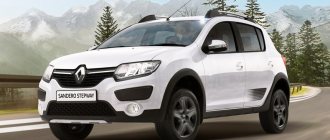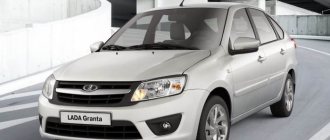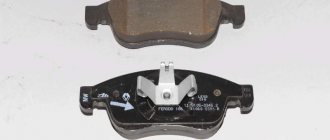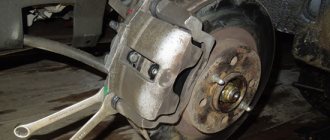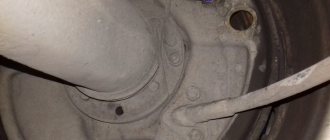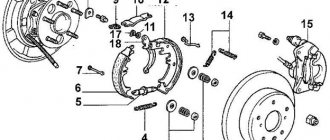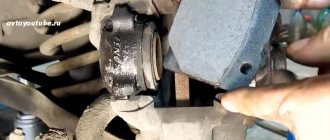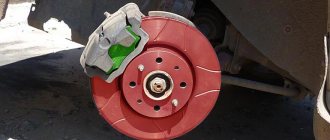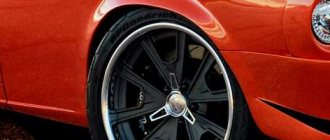Replacing the front brake pads of a 2013 Hyundai Solaris (aka Hyundai Accent 4) is shown in this photo report. The procedure is responsible, but simple enough to change the pads yourself.
To replace you will need: a jack and stops, a wrench or ratchet with a 14mm head, lubricant for brake mechanisms, a special tool for pressing in the caliper piston, a set of new front pads.
2272-6-12-03-11
To do this, use sliding pliers to press the piston into the cylinder, being careful not to damage the boot.
Before installation, we clean the brake mechanism parts from dirt and corrosion, especially the brake pad seats in the caliper guide plates and the pad guide.
It is prohibited to use gasoline and diesel fuel to clean brake mechanisms.
If the protective covers of the guide pins are torn, replace them with new ones.
We assemble the brake mechanism in reverse order.
After replacing the pads on both front wheels, press the brake pedal several times to set the gaps between the pads and discs.
[We save up to 5,000 rubles on Hyundai Solaris maintenance] [Hyundai Solaris maintenance for 15 thousand kilometers] [Hyundai Solaris maintenance for 45 thousand kilometers] [Hyundai Solaris maintenance for 60 thousand kilometers] [Do it yourself Maintenance - general recommendations] [Safety rules for carrying out vehicle maintenance yourself] [ Tools required for maintenance of Hyundai Solaris]
Replacing the brake pads of the front wheels of Hyundai Solaris
Replacing discs and pads. Hyundai Solaris
For what reasons do you need to change discs and pads?
Their wear and tear is a natural phenomenon, and one might even say programmed. Not a single manufacturer will name the mileage in kilometers, which can be considered a standard; too many factors influence this. Operating conditions, driving style, vehicle modification, etc. But definitely not one ten thousand kilometers, and not a couple of months. The brakes should not make any sounds or smells, the wear of the discs and pads should be uniform, the braking process itself should be predictable and adequate, the pedal should be informative. And no vibrations! Are you seeing deviations from the pattern? So it's time to change the discs and pads. But do this not blindly mechanically, but thoughtfully, distinguishing cause from effect. So as not to regret later about wasted time and money, not to curse manufacturers or crooked mechanics, as is our custom :-) And the teaching aid for this lesson will be one of the most popular cars on our roads - Hyundai Solaris
Diagnostics
If we talk about searching for the reasons for increased or uneven wear of the front discs and pads, then we need to start... with the rear axle, oddly enough:
And the whole point is that for uniform braking, the load is proportionally distributed on both axles, and if the rear for some reason does not cope with its task, the entire load falls on the front. At a minimum, this leads to overheating, and entails various consequences. Let's look carefully:
Yes, there is a reason to deal with the rear brakes
And why? Because no one has heard of rear brake prevention.
Let's return to diagnostics. Before removing the wheels, you need to shake them:
And twist:
What are we looking for? Backlashes. Broken joints can cause vibration when braking, a loose wheel bearing can cause uneven wear and increased free play of the brake pedal.
We remove the wheels and look at the front of the work:
Clearly the brakes on this car were not working as intended. Let's start disassembling:
— Unscrew the bolts securing the caliper to the guides:
What to do next? Many people do this:
And this is the wrong decision. I can argue: since we have undertaken not only to replace the pads and discs, but also to evaluate the performance status of the brakes as a whole, this must be done consistently and without missing any details. In particular, check the condition of the boot that covers the caliper piston. And for this it is necessary that it (the piston) is not yet recessed into the body:
It’s even better to look under the rubber band to assess the condition of the piston surface. Otherwise, you know, all sorts of surprises are possible, as happened recently with Tiguan
- recess the piston using a special tool
And this is also part of the diagnosis. Because when using a tool, you can adequately assess the smoothness and uniformity of the stroke, as well as the force that you have to apply to press:
Let's say there are no complaints about the caliper. What about the hoses?
Is everything okay too? Great! Hanging the caliper:
What do we see?
At least one point, uneven wear of the pads, can be crossed out. But what is the reason for damage to discs, rapid wear of pads and vibration during braking? The points:
— try to remove the pads from the bracket:
Do they come out hard, with effort? It is not normal. Most often the problem is in those places where the pads move along the bracket:
— unscrew the bracket:
Put it aside, we will return to this issue later.
Where does the vibration in the pedal come from when braking?
One of the most common reasons is corrosion:
Damage to the discs also leads to uneven wear of the pads:
Another cause of vibration is disc distortion. For example, due to overheating. Not because of aggressive driving style, not because of poor quality, and not even because of driving through a puddle. Or at least because the rear brakes don't work well. But you need to make sure that the discs are really warped. And here again you cannot do without special tools. But first:
— how to fix the brake disc on the hub:
— attach the micrometer to the clamp, rest the “tip” as close to the edge of the disk as possible (taking into account the presence of corrosion):
— rotate the hub and observe the instrument readings:
Allowable runout is 0.03 mm. The permissible variation in disk thickness (have you heard of this?) is 0.005 mm
Are you within the standard? Great! Tolerances exceeded? Do not rush to rejoice at the discovered reason. Let me remind you: there is a consequence, and there is a cause. And it is possible that the reason for the disk curvature is not only overheating. It is rare, but crooked hubs also come across. Moreover, which is typical, installing new disks removes vibration for a while. But then she comes back.
— Unscrew the bolts securing the disk to the hub:
- remove the brake disc:
Hub prevention
Yes, yes, it also needs to be prepared for proximity to the new disk. Pay attention to the surface:
Everything that can be called rust must be removed:
— before installing new disks, update the threads of the mounting bolts:
Few people realize that these bolts are needed not only to facilitate installation. After all, it seems obvious that the brake disc is actually tightly clamped between the hub and the wheel, so why else need fasteners? Let's take a look inside the brake disc:
Now imagine: when carrying out any work related only to removing the wheel, dirt from the inner surface of the brake disc can easily get into the gap between the disc and the hub if they are not tightly compressed together...
— take new discs out of the packaging:
517120U000
— install the disk, tighten the fastening screws:
If the disc is not painted, it is stored in a preservative lubricant, which must be washed off:
Prevention of caliper brackets
We pick up the bracket again and figure out why the pads jam in it. The easiest way is to blame the springs, which serve as a gasket between the block and the bracket:
This is the right call. I don’t recommend trying to clean off dirt and corrosion; it’s better to change it right away:
581442K200
But don’t rush to make only them extreme. The bracket itself can also corrode, and dirt, including wear products from the pads, also sticks to its surface. So what? Preventative cleaning:
The cleaned surface must be protected. Anti-creaking paste is quite suitable for this purpose:
- apply the paste to all cleaned surfaces:
— install the plates:
Ready? No! Checking the guides:
What to look for? Integrity of rubber covers, ease of movement, presence and freshness of lubricant:
But there should not be excessive play in the guides in the bracket. Otherwise, there will be no way to get rid of the chatter except by installing new brackets
Please note that the top and bottom guides are different:
The one that is placed in the bracket from above has a rubber tip. Its absence is the reason for extraneous sounds when driving and braking
Even if everything is beautiful and good, it’s not a bad idea to update the lubricant:
Well, if in doubt, change the guides, fortunately there are repair kits :
Now the staples are prepared.
Correct brake assembly
— screw the brackets to the steering knuckle:
— tighten the bolts to 85 Nm:
— open the package of pads:
581014LA00
Pay attention to the presence or absence of overlays:
Some brands allow themselves to reduce the price due to their absence, I suggest purchasing separately as an accessory
— install new pads in brackets:
Make sure they move freely on the bracket
- apply anti-creaking paste to all contact points:
— clean the contact points on the caliper:
— install the caliper in its place;
It is recommended to use new bolts, but if there are none in the kit, then apply a small amount of thread sealant to the old ones:
- tighten the bolts:
25Nm
- screw and tighten the wheels:
— Press the brake pedal several times to bring the pads together.
Now the car is operational and ready for use!
SIGN UP FOR REPLACEMENT OF DISCS AND PADS
Yakov Finogenov
EuroAuto technical specialist
Replacing Front Brake Pads Hyundai Solaris
Brake pads: review on Hyundai Solaris
Only behind the wheel of a one hundred percent serviceable car can you feel confident and enjoy driving.
Replacing rear brake discs and pads [Megane, Scenic] Replacement Replacing brake discs and pads on a Ford Focus 2 In a Ford Focus 2 to the reservoir It seems like one would not like to think that the brakes were really invented by cowards, a car in which they are not in order, safety and maneuverability cannot be frayed.
Buying an economy class car is an indication that the owner is on a limited budget and will treat his four-wheeled friend with care. One of the more common methods to extend the life of a car is timely replacement of consumables.
But if the owner of the car, for example, a Hyundai Solaris, is careful, but does not have extra funds, then he can carry out some simple repairs without contacting official dealers, whose service often costs a pretty penny. For example, with proper care, you can independently change the brake pads on a Hyundai Solaris .
Brake system Hyundai Solaris
In order to confidently undertake replacement of brake pads, you need to have an idea of the entire working brake system of the car, at least in general terms. Solaris is equipped with a hydraulic service brake system, dual-circuit, with diagonally separated circuits. This system is considered one of the safest.
One circuit is responsible for the operation of the brake mechanisms of the left front and right rear wheels; the second works the opposite diagonal. When the brake system is working properly, the two circuits operate smoothly. If any of the circuits fails (depressurizes), its functions are taken over by the second.
In this case, braking will not be as clear and effective. The brake system consists of a vacuum booster, wheel brake mechanisms, pedal assembly, fluid reservoir, head brake cylinder, ABS unit, auxiliary parts, connecting pipes, hoses and fasteners.
The brake pedal is made in a suspended type. A pedal position sensor is built into the pedal assembly bracket, which closes when pressed and transmits a signal to the ECU to start braking.
The purpose of the vacuum booster is to reduce the force of pressing the pedal. It is located between the head brake cylinder and the pedal assembly of the Hyundai Solaris. If the amplifier breaks down, it cannot be repaired.
This part can only be replaced with a new one.
A vacuum booster is attached to the brake head cylinder.
Replacing the brake pads of the rear wheel brake mechanism of a Ford Mondeo 4 rear. There is a reservoir located on the cylinder, which contains fluid for servicing both the brake system and the clutch.
The tank is equipped with a liquid level sensor for timely correction of its presence. It is worth taking action when the level drops below the acceptable minimum level; in this case, the corresponding warning light on the dashboard turns on.
When braking begins, the pistons of the head cylinder change position, which creates pressure in the hydraulic drive, which then drives the wheel brake mechanisms.
In wheel mechanisms, one of the most important functions is performed by brake pads, or, as they are popularly called, “shoes”. They create the braking force through interaction with the moving wheel.
Brake shoes are actively used in all types of wheeled vehicles, not only in automobiles.
The pads are divided into external and internal. They consist of a frame and a friction lining that comes into contact with the surface of the brake disc.
The main characteristic of the gasket is the friction coefficient.
Parts from different manufacturers have different coefficients, but calculations of optimal safe braking figures show that the highest quality coefficient ranges from 0.35-0.45.
How to change the front brake pads on a Hyundai Solaris step by step
The video shows how to replace front brake pads
by car
Hyundai
Solaris. Perform replacement.
Replacing Solaris front pads in 5 minutes
Changing the front brake pads
.
Types of brake pads
When brake pads are applied to braking, a huge amount of thermal energy is released through frictional force, so they are made from durable materials that are resistant to high temperatures. Brake pad manufacturers use their own “recipe” to make linings.
It may contain more than a dozen components, but the mixture is always based on a substance with reinforcing properties. Replacing front pads and brake discs with Asbestos was used to make the friction lining in the first pads.
It absorbs and dissipates thermal energy well and is not expensive. But it had to be abandoned after its harmful properties were discovered. Asbestos was replaced by ceramics, organics and metal.
Self-replacement of rear brake pads Today, there are four main types of friction pads:
- non-asbestos based on organic compounds;
- ceramic;
- semi-metallic;
- metal-ceramic.
The most popular currently are semi-metallic brake pads . Replacing Sandero front pads and question about them. They are durable in use and do not break the bank.
The nuances of choosing the right Hyundai Solaris
Before choosing brake pads for your Solaris, you need to analyze your driving style. In aggressive driving, for example, cheap organic pads will be a waste of money and time.
All brake pads are divided into conveyor (original), aftermarket (original or non-original parts that are supplied to auto parts stores) and cheap pads supplied to developing countries.
It’s stupid to argue that the best pads are the original ones. Stock factory components installed during vehicle assembly are always of good quality.
Replacing front pads on a VAZ 2114 with your own hands | LuxVAZ But what to do if there is not enough money for the original?
In fact, you shouldn’t despair when you hear the price of pads from an official dealer. Of course, they will be selected by a competent specialist, taking into account the general condition of the brake system, and will come directly from the factory and with proven quality. But is it worth overpaying for the original pads, especially if the price will have a significant negative impact on the budget?
There are many component manufacturers on the market who use original technologies in the manufacture of parts. VAZ 2109 replacement of front brake pads and brake discs of VAZ 2109, 2110, 2114, Their quality is often not inferior to factory parts, despite the popular belief that a duplicate is always worse than the original.
Brake system maintenance is mandatory
The need for replacement is due to several reasons, one of the main ones being the minimum thickness of the brake discs. When there is a lot of wear, the volume of metal is not enough to effectively distribute the heat that occurs during prolonged braking. Deformation and, as a consequence, beating may occur. Which is especially noticeable when braking.
If the wear of the front discs exceeds 2 mm, then this is a signal for replacement. The thickness of the new brake discs is 22 mm. The rear discs are different in thickness from the front ones. Their thickness is 10 mm, and the permissible thickness is 8.4 mm.
To determine brake disc wear, use an electronic caliper and measure the thickness in different areas of the disc. Using the average value, determine how worn it is.
The service life of the products is 55-70 thousand kilometers. This is not regulated in the technical documentation, but, as practice shows, it is at this mileage that critical wear appears.
Signs may appear earlier indicating that the disks are at the end of their useful life.
Errors when replacing pads
To ensure effective front pad replacement, common mistakes should be avoided.
After assembling the mechanism, you should not immediately drive onto a busy road for testing. The need for constant hard braking will impair the performance of new front parts that have not yet broken in.
When replacing, you need to pay attention to the disk. It is also subject to wear and tear. If the surface is worn out, then replacing parts will not improve the efficiency of the mechanism; in this case, the front disc will need to be reinstalled.
It is recommended to avoid sharp braking on the Hyundai Solaris for the first 100-200 km; the undeveloped surface of the parts becomes very hot and begins to burn, which reduces the efficiency of the maneuver and shortens the wear period.
When else is it necessary to replace?
The maximum allowable wear is not the only situation when it is time to think about replacement. Other cases when a car owner will need to do this:
- it was necessary to replace the brake system discs - they are changed along with the pads;
- the linings are oily or cracked, chipped or deep grooves appear on them;
- The pads and linings themselves began to peel off from each other.
Inspections will not be required too often. The Korean manufacturer has equipped the Solaris model pads with convenient acoustic indicators. Thanks to these devices, the car owner will definitely not miss the moment when parts are approaching extreme wear.
Acoustic indicators simplify car diagnostics, which is especially important in urban environments, where you constantly have to brake sharply. When the pads are worn out, a characteristic grinding noise is heard when braking. Having heard it, you should take note of this, be sure to inspect the brake system at the next opportunity and replace the components with new ones.
Wear and consequences
A brake disc, like other car parts, has a limited service life. Manufacturers tentatively indicate this parameter in the vehicle documentation.
Objective correlation depends on the following factors:
- car mileage;
- driving style;
- the condition of the road surface on which cars most often drive;
- passenger and luggage load or lack thereof;
- features and quality indicators of installed elements.
Example of a worn disk
What's suitable
The table shows the manufacturers of popular brake discs for Solaris 2:
| Manufacturer | Item number |
| AMD | BD272 |
| ASHIKA | 600KK18 |
| Bosch | 0986479367 |
| JAPKO | 60K18 |
| NIBK | RN1956 |
| TEXTAR | 178949 |
| Zimmermann | 320380320 ( rear discs – last three digits 352) |
Which front pads to choose
It is better to opt for the original models 581011RA05 or 581014LA00, which are supplied as standard with the Hyundai Solaris. The following companies have proven themselves well:
- P18025 Brembo;
- Sangsin SP1400 and Brake SP1399;
- GDB3548 TRW;
- SANGSIN SP1399;
- 2534801 Textar;
- ESD7052 (Yes-Q);
- D11268MH KASHIYAMA
- Hankook FPH27 Frixa.
Important! Kits are purchased for two front wheels at once, regardless of whether the system on one of them is in good condition or not. Parts are changed at the same time.
If this is not done, the car will move to the side when braking.
Hyundai pads are equipped with a metal system for acoustic wear detection
Step-by-step instructions for replacing front pads
Let's see how to change the front pads with your own hands in the garage using a set of standard tools. The first step is to remove the wheels. Then you need to insert a flat-head screwdriver with a wide blade into the window in the caliper between the pads and the disc. In this way, the brake pads are spread and the piston is recessed into the cylinder. Next, use a 14mm wrench to unscrew the bolts securing the caliper to the pin. The caliper is then removed from the guides. There is no need to disconnect the brake hose. The caliper is tied to the spring. Next, remove the outer block from the guide, and pull out the inner block in the same way. Using a screwdriver, remove the guide plates.
Next, you should install new pads, but before that you need to press the piston into the cylinder as much as possible. This is how the front brake pads are replaced on a Hyundai Solaris. This procedure can be done with your own hands in an hour.
Description
To replace you will need: a jack and stops, a wrench or ratchet with a 14mm head, lubricant for brake mechanisms, a special tool for pressing in the caliper piston, a set of new front pads.
Front wheel of Hyundai Solaris 2013.
Changing the front pads is quite simple and easy, since when developing the Hyundai Solaris, manufacturers took this nuance into account and made it as accessible as possible for the average person. Let's look at the step-by-step process of replacing the front brake pads.
Choosing which brake pads are best for Hyundai Solaris
Last year I bought a Hyundai Solaris, a popular car in Russia. And its popularity lies in its simplicity, reliability and inexpensive maintenance. The process of servicing the Solaris brake system is very simple: monitoring the wear of brake discs, replacing the front and rear pads.
These are all simple operations that anyone can do with their own hands. But choosing which consumables to use is more difficult, since there are a huge number of brands and it’s easy to buy something of poor quality.
What types of pads are there?
In short, any pad, regardless of brand, can be one of four types:
- Ceramic pad. The most expensive, the toughest, the most silent, the lightest. They are made from ceramic fibers, they generate virtually no dust and wear out the brake disc.
- Semi-metallic block . The composition is half metal, it can be copper powder, graphite or iron powder. Their disadvantage is that they do not tolerate frost and can be quite noisy. The resource is not very high.
- Organic block . Consist of rubber, glass and polymer fibers. Quiet and soft pads practically do not wear out the brake disc, but quickly wear out themselves.
- Low metal block . About 20-25% of hard steel or copper is added to the organic composition. This improves heat transfer and extends the service life. Excellent frictional properties, but can be noisy and generate dust.
- Since Solaris is far from a sports car, expensive ceramic pads would not be appropriate here.
From a cost perspective, it doesn't really matter how hard the brake pads are - if they are soft, frequent replacement will be necessary, but you can save on expensive discs. If the pads are hard, then they are changed less often, but the disc wears out more intensively. It all depends on your driving style.
The best choice is the original pads (Mobis/Sangsin)
- Original Mobis pads, which are installed from the assembly line. Catalog number 58101-1RA05 for the front ones, 58302-1RA30 for the rear ones. The cost is approximately 2500 rudders. They are sold complete with brackets, but for the aftermarket they are marketed under the Sangsin brand.
Features of replacing rear pads
The rear calipers have design features despite the fact that, like the front ones, they are disc brakes. In order to recess the brake piston in the rear caliper to its initial position, the use of a special tool is required. The brake piston returns to its initial position, rotating around its axis. To do this, you need to press the piston and also screw it clockwise at the same time.
For more convenient access to the piston, you need to unscrew both guide bolts. If you don’t have a puller, then try using a handy tool, such as pliers, to turn it. You also need a device to simultaneously press the piston. Do not rush to dismantle the unit by disconnecting it from the pipelines. In this case, you will have to bleed the brake system to remove air.
Required Tools
Necessary equipment for replacing pads on Hyundai Solaris (2014, 2015, 2016, 2022, 2018):
- jack;
- balloon key;
- flat screwdriver (large);
- pliers;
- spanner or open-end wrench;
- metal brush;
- lubricant for calipers and pads, sealant for bolts.
A metal stopper under the rear wheels will come in handy (it can be replaced with a wooden, wedge-shaped beam). The device is necessary to fix the rear wheels so that the Hyundai Solaris does not roll when the body is jacked up.
When to change?
You may be interested in: DIY ATV frame - tips and assembly features
The manufacturer does not provide clear regulations on the time frame for replacing the front brake pads on the front wheels. The driver must monitor their wear himself. But the pads must be changed if the disc has been replaced, oil has gotten on the friction linings, deep grooves have appeared on the working surface as a result of use, cracks, chips. Also, replacement of brake pads on Hyundai Solaris is carried out in the event of separation of the friction linings from the metal base of the pad. In practice, the average time from replacement to replacement for front wheels is 30 thousand kilometers. Rear drum pads have twice the service life. However, the rate of wear depends on a variety of factors.
You may be interested in: The whole truth about tire pressure in Skoda Octavia
The inner pads have an acoustic wear indicator. During braking, a characteristic grinding noise is heard. This means that the pad is worn to the limit. The front pads on this car model can only be replaced as a set. If you replace a pair of pads on only one side, the car may pull to the side during braking.
How do you know when it's time to make a replacement?
A novice driver can understand that the brake pads on a Hyundai Solaris need to be replaced by the following signs. If a car is equipped with a set of alloy wheels along with disc brakes, then the condition of the pads can be conveniently observed through the slots in the discs. The wear will be clearly visible. Another simple option is wear sensors or indicators. They are electronic and mechanical. If an electronic sensor is installed, the corresponding light on the instrument panel will light up.
You can determine pad wear by checking the brake fluid level. If there are no leaks in the system, and the fluid level in the expansion tank has dropped, this may be caused by worn pads. The piston stroke is increased due to thinner pads, so the level drops.
Also, worn out pads will be indicated by a vibration in the steering wheel when braking. This occurs due to deformation of the pads or discs. If, when accelerating to 80 kilometers per hour and sharp braking, the car pulls to the side and you feel a beating on the brake pedal, then you need to replace the brake pads and discs with Hyundai Solaris ones. Don't hesitate on this.
Cooled and solid versions
The rear and front ventilated brake discs consist of a pair of plates secured to each other by wing bridges. Air is pumped into the compartments, followed by cooling of part of the brake system. Such devices do not overheat and show high efficiency in city conditions. Disadvantages include reduced strength and accelerated wear.
Solid structures are stronger, simpler and more durable. In case of overheating, the car owner faces a number of problems (loss of vehicle controllability, wheel jamming, caliper deformation). Non-ventilated discs are suitable for traveling long distances on highways. They require careful braking and a balanced driving style.
As comparative tests show, after wear and a mileage of 20-21 thousand km, the original wheels require replacement. Modifications of the AMD Sport BD-5134 series performed well in testing. They differ from budget analogues in the presence of grooves and perforations. Parts are protected from corrosion and supplied in convenient packaging. Installation of devices is not particularly problematic (installation and maintenance instructions are available).
How to check the condition of the brake disc?
As has already become clear, the most important indicator is thickness. It is this that determines how long the disk can last and when replacement will be required. On a Hyundai Solaris, like on any other car, you can carry out similar diagnostics yourself. To do this, just remove the wheel and check the wear. And then you need to look at the top edge of the disk.
If you want to obtain this knowledge in another way, then a caliper is best, which can measure the exact thickness of the disk and tell you whether replacement is needed. On Hyundai Solaris this parameter should be at least 20 mm. And then, this is the state when it’s too late to think, it’s time to act. Do not forget that thickness is a fundamental indicator, both on the front and rear discs.
It is worth understanding that the disks on the Hyundai Solaris have their own part number. When choosing, you need to trust only him. The article was written in the service book, and information is available both about the front and rear discs. Also, looking at the article number, you can easily find out the cost of front discs in any store in the city, and this is a big advantage for those who do not want to overpay.
It is also worth noting that both front discs need to be changed at once, both on the left and on the right. This rule appeared for a reason, it is completely justified and understandable to any person who can think logically and understands that if the wear on the left part is greater, then the left wheel will slow down longer. And this is a hundred percent skid. When purchasing, it is also important to focus on the article number, because it distinguishes a fake from the original Hyundai Solaris.
Pad selection
The choice of brake elements on the Hyundai Solaris is quite difficult. Many analogue manufacturers offer a wide range of parts, which confuses the average owner. As mentioned earlier, the pads and disc brakes on the Hyundai Solaris differ depending on the engine size. In our case, for Solaris the front ones have the original number -581014LA00. The average cost is 5,500 rubles per set.
Install the wheel. Install the cap. Screw the wheel.
Dealers and the manufacturer recommend installing only the original, but what to do when you don’t have enough money for it. A person begins to look for ways to save money and finds a number of analogues, from a cheap option to expensive spare parts. Let's look at what kind of brake pads there are on Hyundai Solaris
| Name | Catalog number | List of analogues |
| BM-Motorsport | FD 6001 | 1000 |
| Toko | T2103027L | 1100 |
| Mando | MPH46 | 1100 |
| Hsb | HP0047 | 1100 |
| Nipparts | N3600550 | 1100 |
| Profit | 5000-0625 | 1200 |
| Febest | 1201-SBF | 1500 |
| Finwhale | V1017 | 1500 |
| Japan Parts | PA-K24AF | 1500 |
| Denckermann | B111324 | 1500 |
| Fenox | BP43151 | 1600 |
| Bremsi | BP3470 | 1700 |
| Valeo | 301021 | 1700 |
| Meyle | 025 253 4818 | 1700 |
Factory recommendations
As always, the manufacturer recommends replacing pads only at a branded or dealer service station. Our man, having listened to everything and found out the price, decides that he needs to save money and replace them himself. Of course, sometimes garage repair difficulties arise, but this is not a frequent occurrence and everything, as a rule, is resolved very quickly.
Reasons for accelerated wear
The rate of wear is most often influenced by two factors. The first is illiterate operation of the brake system. Considering the fact that the Hyundai Solaris is equipped with a relatively powerful engine, most drivers prefer a more aggressive driving style. Sharp acceleration forces the driver to press the brake pedal more often. Aggressive driving leads to faster pad wear. Also, most modern drivers have no idea about engine braking, but this technique allows you to increase the time for replacing brake pads on a Hyundai Solaris by two or more times.
The second factor is an attempt to save money and the installation of cheap pads, where inappropriate materials were used for the production of friction linings. Such pads have a shorter service life. In addition, due to low-quality linings, discs and drums wear out faster.

